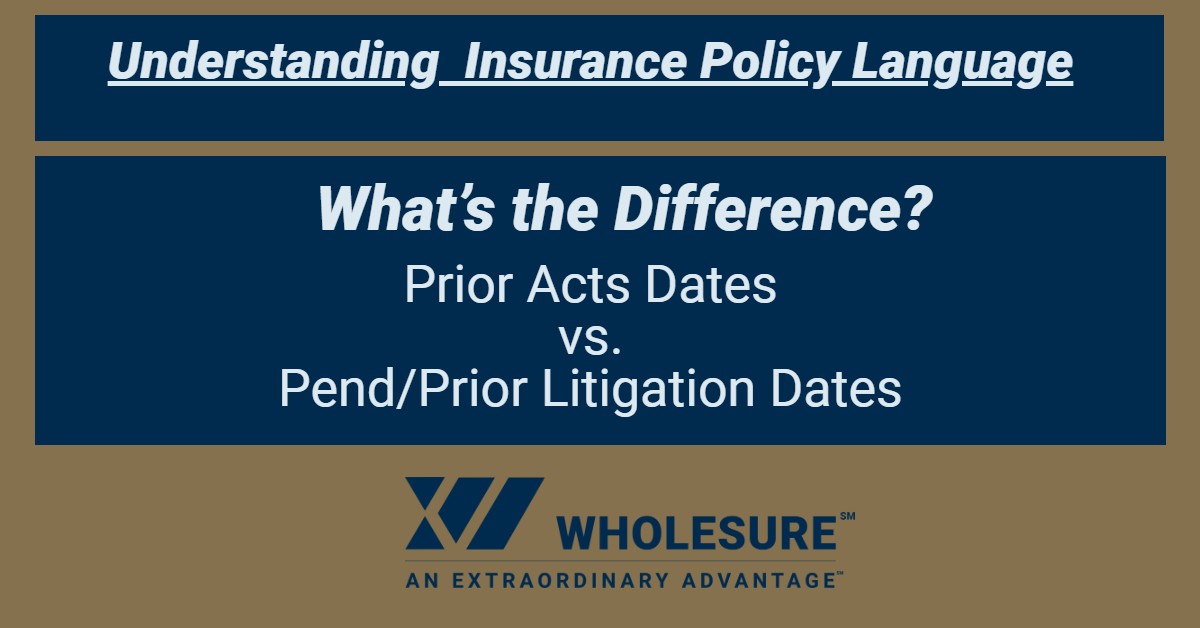A common mistake made by those who aren’t well-versed in claims-made coverage, and even those who are, is conflating a policy’s Pending and Prior litigation date with the Prior Acts date. The importance of understanding the difference between these two features is significant and can lead to significant E&O claims if not addressed properly.
First, it’s important to understand how a Claims Made policy works, as opposed to what happens with an Occurrence form. In Occurrence forms, the carrier that wrote the policy at the time of the Wrongful Act (i.e., the error that led to the eventual lawsuit and claim) is responsible for coverage, even if that policy has since expired or has been cancelled.
On the other hand, the Claims Made policy form is the industry standard for almost all Professional Liability coverage. A Claims Made form is designed to be covered by the carrier in place at the time a claim is filed, rather than being tied to when the Wrongful Act occurred. Within this form, the Prior Acts date- also known as a Prior Acts Exclusion or a Retro Date- is the date before which there is no coverage for Wrongful Acts and creates a window of time in which there is coverage (from the Prior Acts date to present).
So, if an insured purchases coverage today, and they did not carry coverage prior to today, then their Prior Acts coverage would start today and move forward, covering work they do after this point, but not anything they did before. Likewise, if the insured first purchased coverage on 1/1/2010, and a claim is filed for an act that took place last year, then the Prior Acts date would be far enough back for coverage. But if the claim was for a mistake that was made in 2009, then there would be no coverage.
It’s also important to note that this date should move from one policy to the next, through each renewal, regardless of if the insured renews coverage with the same company or moves to a new carrier. Unless there are extenuating circumstances, like adverse claim history that results in a firm purchasing an Extended Reporting Period and starting fresh with a current Prior Acts date, all competing carriers should use this date in their rating and honor the existing Prior Acts date if the insured moves coverage.
Unlike the Prior Acts date, the Pending & Prior (P&P) Litigation date does not address Wrongful Acts and does not move to a new carrier if an insured moves coverage. This date stipulates that if there is any pending litigation against an insured or if there has been previous litigation against that insured, no such situations would be covered by the policy being put in place. Most often, this date is the same date that an insured moves coverage to a new carrier. The new carrier wants to be sure that there’s no litigation in an insured’s history they aren’t aware of, but if there is, the P&P would effectively exclude those matters (rather, those matters should have been covered by the carrier in place prior to the move, or not covered at all if no policy was in place at the time).
Moving to a new carrier will almost always result in the P&P date changing to the effective date of that new policy, but after an insured moves to the new carrier, the P&P date should remain the same at each renewal until coverage is moved again.
About the Author
Raffi Kodikian is a Vice President and Lawyers Professional Liability Practice Leader with Wholesure. Raffi assists retail insurance agents across the Country with securing professional liability insurance solutions for law firms of all sizes. Raffi can be reached at [email protected].

